The defeat of the German army near Moscow
The general setting
In October – November 1941, the German army tried to break through to the Soviet capital, Moscow, defeat the main forces of the Red Army and thereby end the war in its own favor. In the near approaches to Moscow furious battles were seething. The enemy in these battles was exhausted and drained of blood. On November 27, Quartermaster General of the General Staff of the Ground Forces Wagner reported to Halder: "Our troops are on the eve of a complete depletion of material and human forces." During the second stage of the general offensive against Moscow, the Germans lost over 155 thousand killed, wounded and frostbite. There were high losses in the material part.
There was a turning point in the battle for Moscow. Later, recalling this moment of the war, G. Guderian wrote: “The attack on Moscow failed. All the sacrifices and efforts of our valiant troops were in vain. We suffered a serious defeat ... ". But Hitler did not want to accept the failure of the idea of a Blitzkrieg, he insisted on continuing the offensive. The front command also proceeded from the fact that the forces of the Red Army were exhausted in a hard struggle. The commander of the Army Group "Center" von Bock, in an order from 2 December 1941, noted that "the defense of the enemy is on the verge of its crisis." However, the military-political elite of the Third Reich was wrong. Despite the great sacrifices suffered by the Soviet country and the army near Moscow, the crisis in the defense of the capital has already been overcome. The mobilization possibilities, the socialist system and the national economy of the USSR proved to be much more stable than they were expected in the West. The USSR model of the end of 1930 - the beginning of 1940 - s was much stronger than the Soviet Russia of the period 1920 - the beginning of 1930 – s.
The Soviet Union withstood the first, strongest and most terrible blow, and gradually began to rebound, building up military and economic opportunities, mobilizing all its enormous potential for future victory. This led to a change in the overall situation on the whole front. The enemy could not successfully attack on the entire front. In the second half of November, the Red Army launched strong counterattacks in the north and south of the country, freeing Tikhvin and Rostov-on-Don. The German High Command could no longer withdraw troops from the northern and southern strategic directions in order to strengthen the position in the central (Moscow) sector. And at the front near Moscow, the German troops were stretched over a thousand-kilometer front, a significant part of them (9-I and 2-I field armies) was involved in the fight against the troops of the Kalininsky and the right wing of the South-Western fronts. This eased the pressure of Army Group "Center" on the Western Front, directly covering the capital. Not having serious reserves, the Germans by the end of November lost the opportunity to continue the offensive. And their shock mobile groups were weakened, exsanguinated by protracted heavy fighting, they lost their initial penetrating, mobile capabilities. At the same time, the forces of the Soviet fronts strengthened and increased. The headquarters, in spite of the complexity of the situation near Moscow and in general at the front, sought the opportunity to reinforce the Western front, to create reserves in its rear and to form strategic reserves.
Thus, during the summer-autumn campaign of 1941, the Wehrmacht achieved impressive success - captured the Baltic States and blocked Leningrad in the north, occupied the western regions of the country and went to the near approaches to Moscow, captured Ukraine, Kharkov, a significant part of the Donbass and almost all of Crimea. However, the German army could not immediately take Leningrad, moved to its long siege, immediately break through to the Caucasus, take Sevastopol. German troops could not and take the Soviet capital - Moscow. As a result, the German plan for a “blitzkrieg” against the Soviet Union was thwarted by the stubborn resistance of the Red Army and the people as a whole.
The socialist system showed high efficiency and stability, continuing to work and even increase the basic indicators even in the conditions of the most severe war and occupation by the enemy of the most important industrial and agricultural areas of the Western Union. The German military-political elite (as well as the masters of England and the United States, who created the Third Reich project) miscalculated and underestimated the spiritual, military, economic, and scientific potential of Soviet civilization. Already in 1941, the collapse of Nazi Germany became apparent. The heroes of Brest, Odessa, Sevastopol, Moscow, Leningrad and many other cities, towns and unknown places showed the invincibility of the Soviet Union (Russia) and the people in open battle. Hitler signed the death sentence of the Reich, starting a war with the Russians.
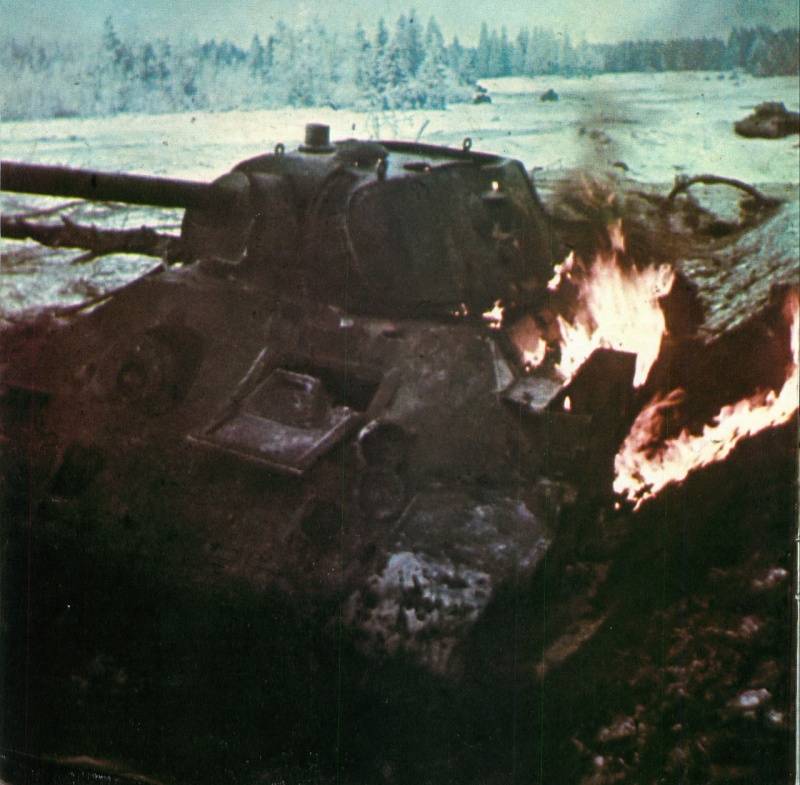
A burning Soviet T-34 tank shot down during a battle near the town of Klin
Preparing the offensive
With the beginning of winter and the vast expanses of Russia, the enemy was not expected to win, but to a catastrophe, a harbinger of a future defeat in the war. The Soviet Stavka, having waited for the exhaustion of the forces of the enemy near Moscow and correctly assessing the existing correlation of forces, at the end of November set about preparing a counteroffensive. The main role was assigned to the troops of the Western Front. The stake transferred 1 shock, 10 and 20 armies to the front from their reserves. The immediate task of the counterattack was to smash the attack groups of the Army Group Center on the flanks of the Western Front and eliminate the immediate threat to the Soviet capital, and to tie down enemy troops in the center of the front, and then go over to a general offensive.
By early December 1941, the Army Group Center had more than 800 thousand people, about 10,4 thousand guns and mortars, 1 thousand tanks and over 600 aircraft. Taking into account the reinforcements received, the Soviet fronts defending the capital had about 720 thousand people, 5900 guns and mortars, 415 rocket artillery installations, 670 tanks and 760 aircraft. The Western Front, despite the transfer of the new three armies, did not have an advantage over the enemy. The Kalinin and Southwestern fronts also did not have superiority over the enemy, even in the directions of the main attacks.
However, the psychological factor was on the side of the Red Army. The brutal massacre under the walls of Moscow broke down the morale of the “invincible” Wehrmacht. The Germans in Europe have not yet had to deal with such fierce resistance and resilience of the enemy. Russians stood to death. I had to forget about the blitzkrieg, the war was dragging on and carrying off more and more people. The diaries and letters found and killed or captured by German soldiers and officers often indicated a radical change in the mood of the German troops. Thus, the corporal Otto Saalfinger, in a letter to his parents, noted: “Very little is left to Moscow. And yet it seems to me that we are infinitely far from her. We have been marking time in more than a month. How many during this time lay our soldiers! And if you collect the corpses of all the dead Germans in this war and put them shoulder to shoulder, then this endless ribbon will stretch, perhaps, to Berlin itself. We walk along German corpses and leave our wounded in the snowdrifts. Nobody thinks about them. Wounded is ballast. Today, we are walking over the corpses of those who have fallen ahead: tomorrow we will become corpses, and the tools and the caterpillars will also crush us. ”
The Soviet high command systematically prepared for a counteroffensive. Strategic reserves were created and maintained well in advance, they were promptly pushed onto the flanks of the German strike forces and thrown into a counteroffensive. The strike followed when the Wehrmacht, exhausted and bloodless in long and heavy offensive battles, did not have time to regroup their troops for defense, nor to consolidate themselves on the lines reached. The Germans did not have time to get reinforcements from Western Europe.
Offensive
5 December 1941, the Kalinin Front troops launched an offensive and wedged into the enemy defenses. On December 6, the troops of the Western Front launched an offensive, striking the enemy north and south of the capital, and in the Yelets area, troops of the right wing of the Southwestern Front attacked. A large-scale offensive of the Soviet troops was launched near Moscow. His training was well disguised, and the German command was taken by surprise. The Germans believed that the Russian troops were completely bloodless and incapable of a strategic offensive. Halder, Commander-in-Chief of the German Land Forces Brauchitsch and Commander of the Army Group Center, Bock until the last moment thought that Soviet troops were completely exhausted, that they did not have large reserves and their resistance was already at the limit of capabilities. It was widely believed that the fate of the Moscow battle would be decided by the “last battalion” thrown into battle. Therefore, the Germans attacked to the last, trying to take Moscow. However, as subsequent events showed, the German military-political leadership made a fatal miscalculation.
As a result, the Germans were forced to admit the failure of their assault on the Moscow positions. 8 December 1941, the German High Command ordered his troops to go on the defensive. In the directive No. 39, the German Headquarters ordered: "The main forces of the troops in the East as soon as possible go on the defensive." However, the strategic initiative was already in the hands of the Red Army. On December 16, the German General Headquarters demanded that the Army Group Center not allow a significant retreat, army commanders, formation commanders and all officers were asked to “force the troops to defend their positions with fanatical persistence” in order to gain time before the reinforcements arrived.
The main blows struck the troops of the Western Front. On its right wing, acting against the German 3 and 4 tank groups in the general direction of Klin, Solnechnogorsk and Istra, attacked the 30-I, 1-I shock, 16-I and 20-I armies, as well as part of the forces 5 th shock army. German defense could not withstand the onslaught of Soviet troops. The retreating German troops, trying to hinder the movement of the enemy, used the "scorched earth" tactics, burned settlements, houses, or mined them. December 15 The 1 shock and the 30 armies liberated Klin. The troops of the 16 Army by the end of 8 December drove the enemy out of Kryukov, 11 December - the destroyed city of Istra. During the withdrawal to the western coast of Istria and the Istra reservoir, the Germans destroyed all the crossings, blew up the reservoir dam, which led to serious problems in forcing the water barrier. The West Coast Germans mined and organized a strong fire cover. However, the command of the 16 Army prepared in advance the mobile groups of troops, which bypassed the enemy from the flanks and provided rifle divisions with the crossing of the Istrian border.
The troops of the 20 Army advancing to the north liberated Krasnaya Polyana, December 11 - Solnechnogorsk. The troops of the right wing of the 5 Army, advancing south of the 16 Army, by their offensive contributed to the development of its success in the Istra-Volokolamsk area. Particularly successful was the 2 Guards Cavalry Corps of L. M. Dovator. After passing through the front line through a dense forest southwest of Zvenigorod, the Soviet cavalry made a breakthrough, cutting off the German troops' withdrawal routes to Volokolamsk and Ruza. In these battles of December 19, General Lev Mikhailovich Dovator was killed.
The troops of the Kalinin front 16 December liberated Kalinin and advanced to Staritsa and Rzhev. By the end of the month, rejecting the enemy on 50 - 100 km, they reached the line of Volga, Rzhev, Zubtsov, Pogorelo Mound. Here the front has stabilized. The troops of the right wing of the Western Front in the second half of December captured the cities of Vysokovsk, Teryaev Sloboda, Volokolamsk and the main forces reached the line of the Lama and Ruza rivers, where the enemy prepared a strong defense.
Thus, during the December battles, the 9-I field 3-I and 4-I tank armies suffered a serious defeat. The threat to the Soviet capital from the northwest was eliminated. The advancing Soviet troops liberated hundreds of settlements in the Moscow Region and cleared the important Kalinin-Moscow railway.
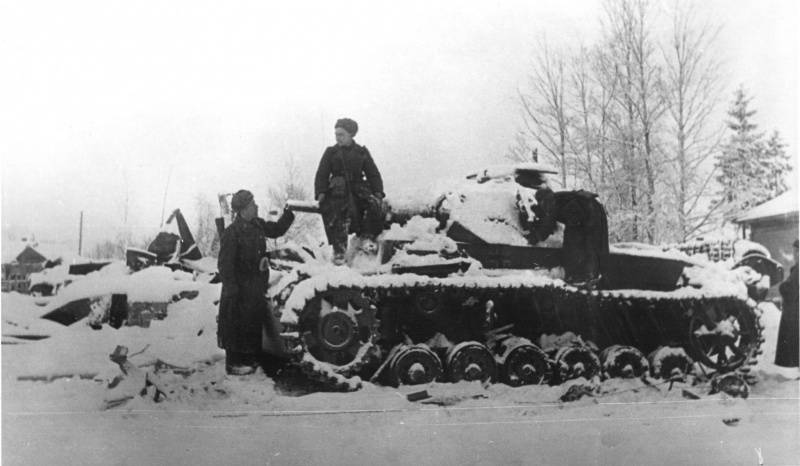
The Red Army in the German tank Pz.Kpfw. III, captured in Kryukovo near Moscow
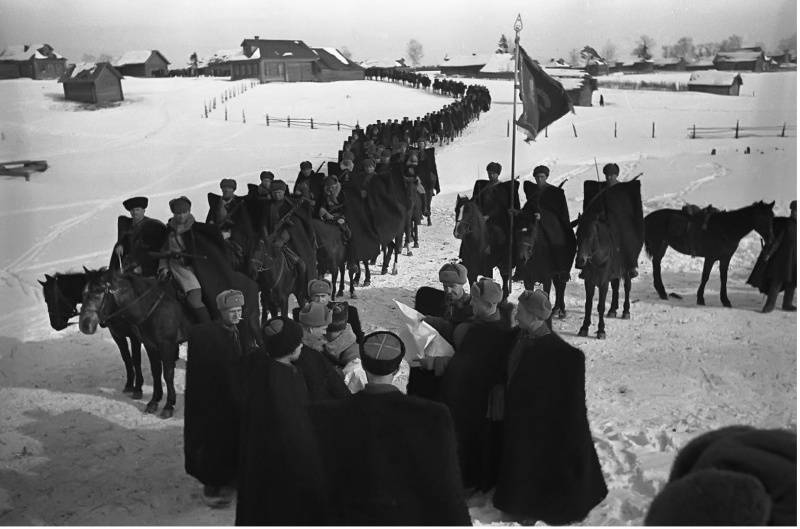
The cavalrymen of the 2 Guards Cavalry Corps of the 16 Army of the Western Front, in the center with a map in their hands, the commander of the Guard Corps, Major General Lev M. Dovator
Against the southern wing of the Army Group Center, the counteroffensive of the Soviet troops also developed successfully. Part of the left wing of the Western Front, the 49, 50 and 10 armies, the 1 Guards Cavalry Corps, interacting with the troops of the right wing of the Southwestern Front, attacked Guderian’s 2 tank army and covered it with south of the 2-th Weihs field army. German troops in this area did not manage to completely surround and take Tula, which was held by units of the 50 Army. The troops of the German 2 Tank Army that were broken into Kostrovo and Revyakino along the Tula-Moscow highway were defeated by the 49 and 50 armies that had switched to the counterattack. The 1-th Guards Corps of General A.P. Belov was active. The cavalrymen on the night of December 7 broke into Mordves. In the morning of December 6, the fresh 10 Army under the command of Lieutenant-General F. I. Golikov launched an offensive. December 7 was released the city of Mikhailov.
As a result, in the very first days of the counter-offensive of the left wing of the Western Front, Soviet troops captured the cities of Mordves, Mikhailov, Venev, Stalinogorsk, Epifan. The German 2 Tank Army defeated in the Tula region retreated, throwing heavy weapons and equipment. Developing success, our troops drove the enemy out of Bogoroditsk, Dedilovo, Aleksina, Plavsk. December 15 50 Army troops liberated Yasnaya Polyana. At the same time, the right wing of the South-Western Front 9 December, after four days of hard fighting, occupied Elec. Developing the offensive, our troops liberated Chern, Efremov, Livny and hundreds of other settlements. German 2-I field army suffered a defeat. 18 December The headquarters restored the Bryansk Front, which launched an offensive in the general direction of Bolkhov and Orel, supporting the movement of the Western Front. 2-I tank army was defeated and on a broad front was rejected for Oka. The approaches to the capital were provided from the south.
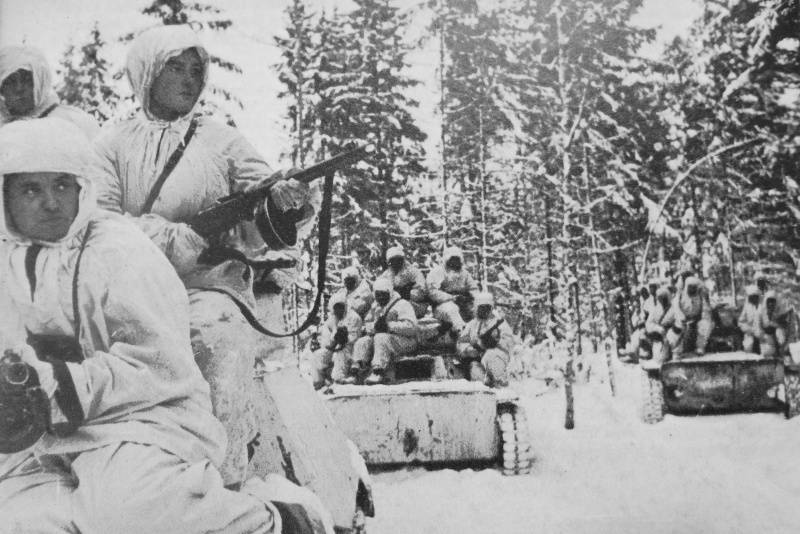
Soviet T-40 tanks with assault rifles in machine guns in the winter forest
During the retreat of the German troops, an 30-kilometer gap appeared between the left flank of the 2 Tank Army and the right flank of the 4 th Field Army. The command of the Western Front from the 50 Army formed the operational group of troops V. S. Popov. Speaking on the night of December 18 from the area east of Tula, the group’s forces overcame 90 km in three days and by the evening of December December 20 unexpectedly reached the enemy for Kaluga. The struggle for this large knot of roads and an important supply base of the German army continued for 10 days. 30 December Kaluga released. Soviet troops also occupied Kozelsk and Belev.
In the second half of December, the counteroffensive unfolded in the center of the western front. The troops of the 33 and 43 armies broke through the enemy defenses at the line of the r. Nara and freed Naro-Fominsk, Maloyaroslavets and Borovsk. 49-I army, advancing from the Serpukhov region, crossed the Oka River and, coming to the west bank of the river, took the battle with Tarusa.
Thus, the first stage of the counteroffensive near Moscow by the beginning of January 1942 was successfully completed. German Army Group “The center that had previously attempted to take Moscow, the Soviet capital, the country's largest industrial center and communications hub, was defeated and thrown back from the city on 100-250 km, and the troops of the Soviet fronts swept it from the north, east and south. The Moscow and Tula regions, a number of districts of other regions and hundreds of settlements were freed.
The Red Army won up in the largest and most difficult battle for Moscow. Germany suffered the first major defeat in World War II and the Great Patriotic War. The enemy’s plan for a “lightning war”, with the aim of destroying Soviet civilization and the people, was finally buried in the fields of the Moscow Region. "Historical victory in the Moscow battle, - noted Marshal A.M. Vasilevsky, - which became a triumph of the Soviet Armed Forces, marked the beginning of a radical turn not only in the Great Patriotic War, but also in the entire Second World War. The defeat of the Nazis near Moscow triumphantly ended the first, most difficult stage of the struggle on the path to a complete and final victory over fascist Germany. "
The Moscow battle finally dispelled the myth of the “invincibility” of the Wehrmacht. Germany faced the threat of a protracted war for which it was not ready. The Wehrmacht had to prepare for the new “decisive” 1942 campaign of the year. Hitler cleared the command - from December 1941. April 1942 r. Removed generals from the occupied positions of 35, including the commanders of the tank armies of Guderian and Göpner. Field Marshal Brauchitsch was removed from the command of the land forces, the Führer took over this post. Field commanders Leeb, Bock, and Rundstedt were displaced from their posts and the commanders of Army Groups North, Center and South.
The victory near Moscow forced Britain and the United States to intensify cooperation with the USSR in the framework of the anti-Hitler coalition. Japan and Turkey, who were preparing to attack the Soviet Union in the event of Moscow’s fall, in order to get their share of the “Soviet bear” skins, postponed their aggressive plans until the best moment, which never came. This allowed the Soviet government to continue building up forces and assets on the Soviet-German front.
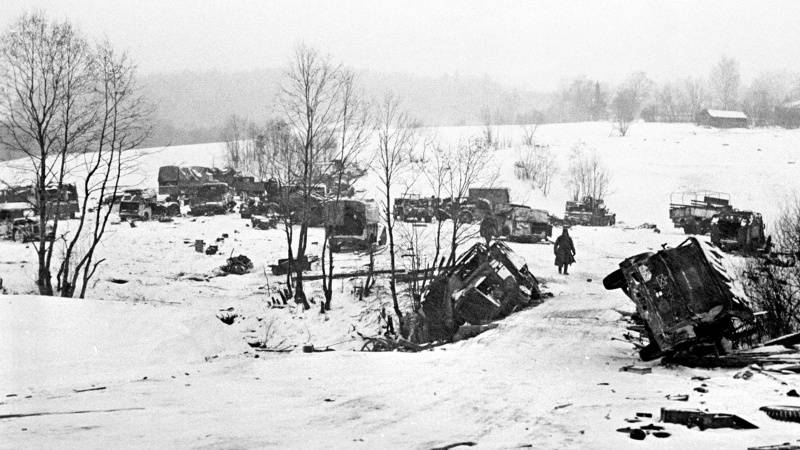
Broken German vehicles abandoned near Moscow
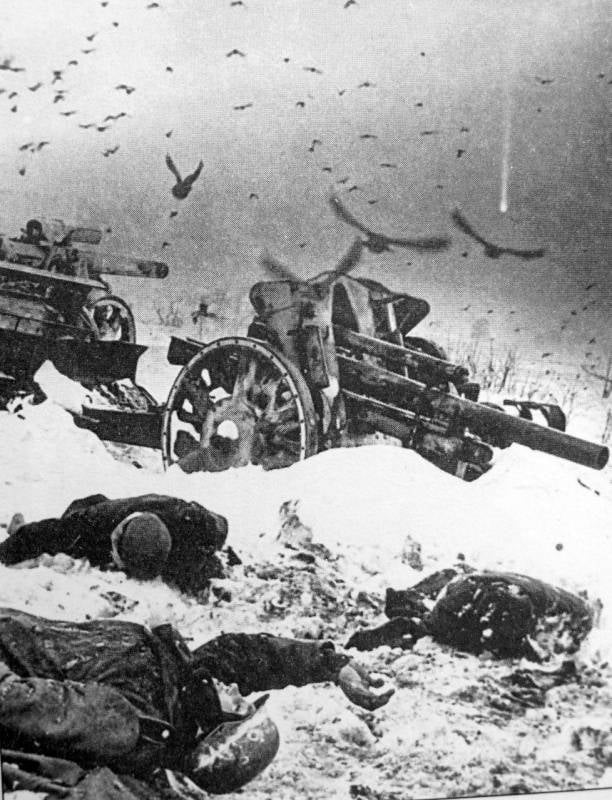
Killed German soldiers and abandoned German artillery during the December counteroffensive of the Red Army near Moscow. For an extra effect, a flock of crows has been added to the photo editing. Photo source: http://waralbum.ru/
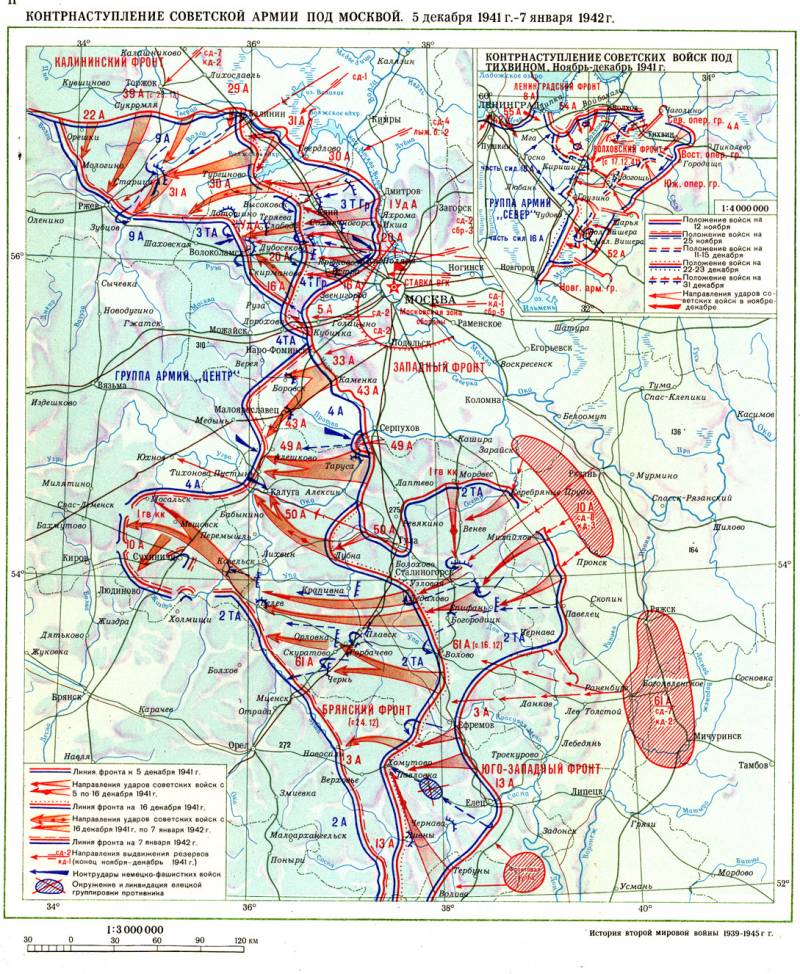
Information